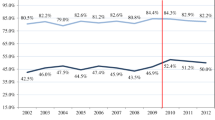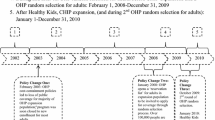Abstract
Even as the number of children with health insurance has increased, coverage transitions—movement into and out of coverage and between public and private insurance—have become more common. Using data from 1996 to 2005, we examine whether insurance instability has implications for access to primary care. Because unobserved factors related to parental behavior and child health may affect both the stability of coverage and utilization, we estimate the relationship between insurance and the probability that a child has at least one physician visit per year using a model that includes child fixed effects to account for unobserved heterogeneity. Although we find that unobserved heterogeneity is an important factor influencing cross-sectional correlations, conditioning on child fixed effects we find a statistically and economically significant relationship between insurance coverage stability and access to care. Children who have part-year public or private insurance are more likely to have at least one doctor’s visit than children who are uninsured for a full year, but less likely than children with full-year coverage. We find comparable effects for public and private insurance. Although cross-sectional analyses suggest that transitions directly between public and private insurance are associated with lower rates of utilization, the evidence of such an effect is much weaker when we condition on child fixed effects.



Similar content being viewed by others
Notes
Following the enactment of the Children’s Health Insurance Program Reauthorization Act of 2009 in February 2009, the official acronym for the State Children’s Health Insurance Program was changed to “CHIP.” In this paper, however, we continue to use the previous acronym.
See Buchmueller et al. (2005) for a review.
An earlier study using data from the 1980s also finds significant differences between children who were insured for a full year and those who were uninsured for a full year, but no significant differences between children with partial year coverage and those who were uninsured all year (Short and Lefkowitz 1992).
The 1996 panel starts in December 1995 and ends in February 2000; the 2001 panel covers the period October 2000 to December 2003; and the first six waves of the 2004 panel covers October 2003 to December 2005.
An exception to this criterion is infants: for children under a year old, we use all months since the child was born.
If we use calendar year weights, the analysis sample is reduced by over 12,000 person-years due to missing weights for those observations. We have run all of our models both using the weights and not using the weights, and the results do not substantively differ. We report the unweighted models in the paper, but weighted results are available upon request.
In the 2004 SIPP panel the topical module on health was only administered twice. This is why we use only two years of data from that panel.
The public insurance category consists mainly of Medicaid and SCHIP plus a very small number of children who qualify for Medicare or are covered by the Indian Health Service. The private insurance category includes employer-sponsored group insurance, which accounts for the vast majority of private coverage, and individually purchased non-group insurance. CHAMPUS, the insurance program for dependents of military personnel, is considered as private insurance because it is employment related.
The mean months in each category may sum to less than 12 because the sample includes infants less than one year old.
While another commonly used measure of access to care is whether the individual has a usual source of care, that measure is not available in the SIPP.
An alternative explanation for this pattern is that changes in reported health status are very noisy proxies for changes in objective health. However, when we include the same health status variables in our utilization regression they are significant predictors of use, even conditioning on child fixed effects. This suggests that changes in subjective health status do reflect real health shocks.
References
Aiken, K. D., Freed, G. L., & Davis, M. M. (2004). When Insurance Status is not Static: Insurance Transitions of Low-Income Children and Implications for Health and Health Care. Ambulatory Pediatrics, 4(3), 237–243.
Buchmueller, T. C., Grumbach, K., Kronick, R., & Kahn, J. G. (2005). The Effect of Health Insurance on Medical Care Utilization and Implications for Insurance Expansion: A Review of the Literature. Medical Care Research and Review, 62(1), 3–30.
Buettgens, M., Nichols, A., Dorn, S. (2012). “Churning under the ACA and State Policy Options for Mitigation”, Urban Institute Report.
Currie, J., & Gruber, J. (1996). Health Insurance Eligibility, Utilization of Medical Care, and Child Health. Quarterly Journal of Economics, 111(2), 431–466.
Gruber, J., & Simon, K. (2008). Crowd-out 10 years later: Have recent public insurance expansions crowded out private health insurance? Journal of Health Economics, 27(2), 201–217.
Ham, J. C., Li, X., & Shore-Sheppard, L. (2009). Public Policy and the Dynamics of Children’s Health Insurance, 1986–1999. American Economic Review, 99(2), 522–526.
Hill, H. D., & Shaefer, H. L. (2011). Covered Today, Sick Tomorrow? Trends and Correlates of Children’s Health Insurance Instability. Medical Care Research and Review, 68(5), 523–536.
Leininger, L. J. (2009). Partial-Year Insurance Coverage and the Health Care Utilization of Children. Medical Care Research and Review, 66(1), 49–67.
LoSasso, A., & Buchmueller, T. (2004). The effect of the state children’s health insurance program on health insurance coverage. Journal of Health Economics, 23(5), 1059–1082.
Olson, L. M., Tang, S. S., & Newacheck, P. W. (2005). Children in the United States with Discontinuous Health Insurance. New England Journal of Medicine, 353(4), 382–391.
Shore-Sheppard, L. (2013). “Income Dynamics and the Affordable Care Act”. Working Paper, Williams College Department of Economics.
Short, P. F., Graefe, D. R., Swartz, K., & Uberoi, N. (2012). New Estimates of Gaps and Transitions in Health Insurance. Medical Care Research and Review, 69(6), 721–736.
Short, P. F., & Lefkowitz, D. C. (1992). Encouraging Preventive Services for Low-Income Children: The Effect of Expanding Medicaid. Medical Care, 30(9), 766–780.
Sommers, B. (2006). Protecting low-income children’s access to care: Are physician visits associated with reduced patient dropout from Medicaid and the Children’s Health Insurance Program? Pediatrics, 118(1), e36–e42.
Sommers, B., & Rosenbaum, S. (2011). Issues In Health Reform: How Changes In Eligibility May Move Millions Back And Forth Between Medicaid And Insurance Exchanges. Health Affairs, 30(2), 228–236.
Acknowledgments
This research was supported by grants from the U.S. Census Bureau and the Robert Wood Johnson Foundation. Neither funding source had any involvement in the conduct of the research.
Author information
Authors and Affiliations
Corresponding author
Rights and permissions
About this article
Cite this article
Buchmueller, T., Orzol, S.M. & Shore-Sheppard, L. Stability of children’s insurance coverage and implications for access to care: evidence from the Survey of Income and Program Participation. Int J Health Care Finance Econ 14, 109–126 (2014). https://doi.org/10.1007/s10754-014-9141-1
Received:
Accepted:
Published:
Issue Date:
DOI: https://doi.org/10.1007/s10754-014-9141-1




